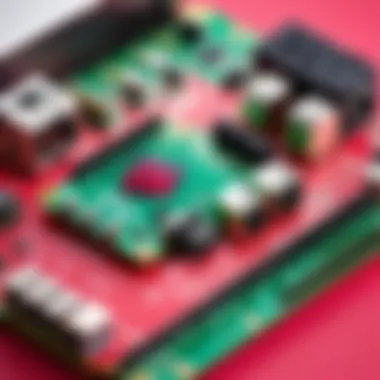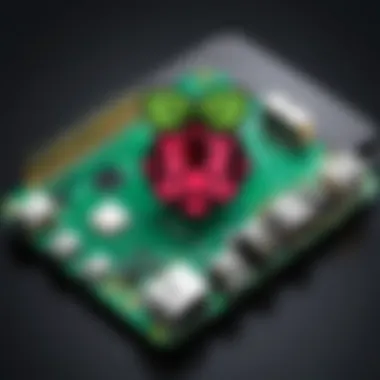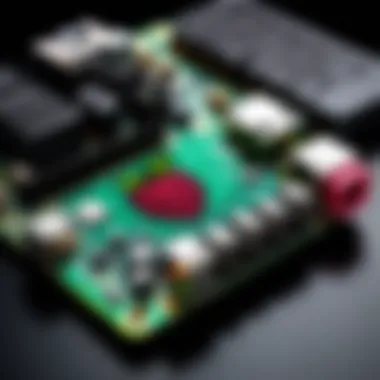Exploring the Raspberry Pi Operating System: Features & More


Intro
The Raspberry Pi operating system is a crucial element for anyone looking to fully utilize the capabilities of this versatile hardware. Understanding its functionality and different options available enables users to optimize their projects effectively. This article provides a detailed overview of the Raspberry Pi OS, considering various user needs, from beginners to more experienced programmers.
By exploring the various aspects of this operating system, including installation processes and its unique features, users can make informed choices tailored to their specific applications. The following sections will outline the significance of different OS versions, the key considerations for selecting an appropriate one based on project requirements, and how to take full advantage of community resources.
As we navigate through this guide, a focus on practical insights will be provided, making the information valuable for developers and hobbyists keen on maximizing the potential of their Raspberry Pi devices.
"The right operating system can enhance your productivity significantly while working with Raspberry Pi devices."
The article aims to foster a deeper understanding of how the Raspberry Pi operating system can impact user experiences and project outcomes.
What is the Raspberry Pi Operating System
Overview of Raspberry Pi
The Raspberry Pi itself is a compact, affordable computing device that has gained immense popularity since its inception. Originally designed for educational purposes in computer science, it has evolved into a tool for hobbyists, engineers, and professionals across various fields. The hardware capabilities of the Raspberry Pi offer users flexibility in terms of computing power, storage options, and connectivity, making it suitable for a wide range of applications, from basic programming to advanced automation projects.
Among the most notable models include the Raspberry Pi 4, which offers improved processing power, increased RAM options, and enhanced video output. Each iteration allows for more extensive and complex tasks, enabling everything from basic coding exercises to running server applications or building IoT devices.
Significance of the Operating System
The operating system selected for a Raspberry Pi carries substantial weight in realizing its potential. Different operating systems cater to various use cases, providing tailored environments that affect performance and ease of use.
An appropriate operating system can significantly enhance the user experience, enabling smoother interactions and minimizing frustration during setup and execution of tasks. Furthermore, certain operating systems support specialized software, tools, and libraries that are essential for specific projects, especially in areas like robotics, media centers, or web applications.
Options such as Raspberry Pi OS (formerly known as Raspbian) provide a beginner-friendly interface, suited for novice users. In contrast, more advanced distributions like Arch Linux ARM may appeal to experienced programmers seeking customization.
Understanding the operating system options can help programmers and tech enthusiasts decide which platform will best meet their project needs, ultimately affecting the outcomes of their endeavors.
Overall, the Raspberry Pi operating system plays a pivotal role in the functionality, performance, and scope of projects undertaken with Raspberry Pi devices. This foundational knowledge sets the stage for deeper exploration into the types of available operating systems and their specific use cases.
Types of Raspberry Pi Operating Systems
The Raspberry Pi operating system landscape is diverse and offers a range of options tailored for various applications. Each operating system brings unique features and capabilities that can significantly affect the experience and outcome of projects. Understanding these types is crucial for anyone looking to leverage the full potential of Raspberry Pi devices. The choice of OS can influence performance, installability, and available software packages. Each option aligns with different user needs, whether it’s learning, media consumption, gaming, or advanced computing.
Raspberry Pi OS (formerly Raspbian)
Raspberry Pi OS is the official and most popular operating system for Raspberry Pi. Based on Debian, it is optimized for the Pi’s hardware, ensuring smooth performance. This OS comes pre-installed with many educational tools and programming languages, such as Python and Scratch. Its user-friendly interface makes it accessible for beginners while still providing advanced capabilities for experienced users.
Key points about Raspberry Pi OS include:
- Performance Efficiency: Designed specifically for Raspberry Pi hardware, it minimizes resource usage.
- Community Support: A vibrant community exists, offering tutorials and forums for troubleshooting.
- Software Availability: Large repositories of software packages are easily accessible.
The continual development of Raspberry Pi OS ensures it stays up to date with the latest security patches and features.
Ubuntu MATE
Ubuntu MATE is another viable option for Raspberry Pi users who prefer a more traditional desktop environment. It’s a lightweight distribution that maintains the familiar Ubuntu feel. MATE offers a rich interface and is well-suited for those who want to use their Raspberry Pi as a desktop computer.
Advantages of Ubuntu MATE include:
- Familiar Environment: It provides a user-friendly graphical interface similar to conventional desktops.
- Comprehensive Documentation: Ubuntu has extensive documentation and resources.
- Robust Software Ecosystem: Access to Ubuntu’s extensive repositories is a significant benefit.
This operating system can be particularly useful for educational environments or users transitioning from standard desktop systems.


Arch Linux ARM
Arch Linux ARM is for more advanced users who want complete control over their system. It adheres to the KISS principle (Keep It Simple, Stupid) and allows users to build their operating system from the ground up. This flexibility can be very empowering for developers and tech enthusiasts who need a tailored environment.
Notable aspects of Arch Linux ARM include:
- Rolling Releases: Always up-to-date software, ideal for developers wishing to work with the latest tools.
- Lightweight: Users can install only what they need, saving resources.
- In-Depth Customization: Offers an unparalleled level of personalization for advanced users.
For those familiar with Linux, Arch Linux ARM can be both powerful and efficient.
LibreELEC
LibreELEC is a distribution built primarily for Kodi, a well-known media center application. This OS transforms the Raspberry Pi into a powerful media center, capable of streaming and playing various formats. It is streamlined and ensures maximum performance for multimedia tasks.
Key features include:
- Optimized for Media: Specifically supports media playback, ensuring no unnecessary background processes.
- Easy Setup: Installation is straightforward, making it accessible even to less technical users.
- Frequent Updates: Regular updates enhance security and features.
LibreELEC is an excellent choice for users looking to build a home theater setup.
OSMC
OSMC (Open Source Media Center) serves a similar purpose as LibreELEC but is built atop Debian and has a more user-friendly interface. It also relies on Kodi for media management and playback. OSMC combines media center capabilities with the flexibility of the Debian base.
Benefits of OSMC include:
- User-Friendly Interface: Intuitive design makes navigation simple.
- Customizability: Gives users better control over settings and software.
- Community Engagement: Active forums provide support and resources.
Those wanting to set up a media center with a more accessible interface may lean towards OSMC.
RetroPie
RetroPie focuses on gaming, allowing users to turn their Raspberry Pi into a classic gaming console. It supports numerous gaming platforms and retro games, packaged under a single user interface. RetroPie can revive your nostalgia for gaming while providing a wealth of titles to explore.
Significant aspects of RetroPie include:
- Multiple Emulator Support: Users can play games from various classic consoles.
- Customizable Control Schemes: Allows users to configure emulators to their preferences.
- Community Contributions: A strong community contributes to extensive game and emulator support.
RetroPie appeals to avid gamers and those wanting to experience classic games on modern hardware.
Installing the Raspberry Pi Operating System
Installing the Raspberry Pi operating system is crucial for anyone looking to utilize this versatile hardware effectively. The operating system enables users to interact with the device, run applications, and perform various computing tasks. Selecting the right version and understanding the installation process can significantly influence the performance and overall functionality of the Raspberry Pi.
In this section, we will explore fundamental aspects of the OS installation, encompasing key considerations, necessary resources, and a clear step-by-step guide for a successful setup. Proper installation not only ensures functionality but also enhances user experience, making it a vital topic for developers and hobbyists alike.
Choosing the Right OS for Your Project
The first step in installing an operating system on the Raspberry Pi is selecting the right one for your project requirements. Different operating systems cater to specific needs, such as gaming, media centers, or general-purpose computing. Some popular choices include Raspberry Pi OS, which is well-suited for beginners; Ubuntu MATE, great for desktop applications; and RetroPie, designed for gaming.
When choosing, consider the following factors:
- Project Goals: Define what you want to achieve by using the Raspberry Pi.
- Hardware Compatibility: Ensure the OS supports your Raspberry Pi model.
- Community Support: A strong community can provide assistance and resources.
- Performance Needs: Different projects may require varying levels of computing power.
Required Tools and Materials
To install the Raspberry Pi operating system, you will need a few essential tools and materials. Gather the following items before starting:


- Raspberry Pi Board: The model should match the OS requirements.
- SD Card: A minimum capacity of 8GB is recommended for most systems.
- Card Reader: To transfer the OS image onto the SD card from your computer.
- Power Supply: Ensure it meets the specifications for your Raspberry Pi model.
- Monitor and Keyboard: Necessary for initial setup and configuration.
- Internet Connection: Helpful for downloading the OS image and software updates.
Step-by-Step Installation Process
The installation process for the Raspberry Pi operating system involves several clear steps, which are outlined below:
- Download the OS Image: Go to the official website, such as Raspberry Pi website, and download the desired OS image file.
- Prepare the SD Card: Use a tool like Balena Etcher or Raspberry Pi Imager to flash the downloaded image onto your SD card. Simply insert your SD card into your computer, select the image, and choose the SD card. Click to start the process.
- Insert SD Card into Raspberry Pi: Once the flashing process is complete, remove the SD card from your computer and insert it into your Raspberry Pi.
- Connect Peripherals: Attach the monitor, keyboard, and mouse. Ensure the power supply is ready.
- Boot Up the Device: Power on your Raspberry Pi by connecting the power supply. The system should boot from the SD card.
- Follow On-Screen Instructions: Configure settings such as language, time zone, and Wi-Fi connectivity as needed upon first boot.
After completing these steps, your Raspberry Pi will be ready to use with the selected operating system, providing a solid foundation for your projects.
Configuring the Operating System
Configuring the operating system on a Raspberry Pi is crucial for optimizing the performance of this versatile device. Proper configuration enables users to tailor settings according to their specific project needs. This step is not merely about aesthetics; it's about unlocking the full potential of the Raspberry Pi. Moreover, a well-configured system enhances stability, ensures quicker load times, and generally improves user experience.
Initial Setup and Configuration
When setting up the Raspberry Pi for the first time, the initial configuration is pivotal. After installing the OS, a user should address basic settings, including language selection, time zone, and network connectivity. Navigating through these fundamental settings can often determine how smoothly subsequent projects proceed.
- Language and Location: Setting the correct language and locale is vital for ensuring that software updates and third-party applications function correctly.
- Network Configuration: Connecting to a stable Wi-Fi network or Ethernet is essential, especially if your projects require internet access.
- User and Password Management: Creating strong credentials for the default user account increases security. Consider changing the default username and password before exposing the device to external networks.
Updating the Operating System
Keeping the operating system up to date is a key aspect of configuration. An outdated OS can lead to vulnerabilities and compatibility issues. Updating ensures that the system benefits from the latest features and security patches. The following steps illustrate how to execute this effectively:
- Open the terminal.
- Execute the command to refresh the package list.
- Follow this with to install any available updates.
Using these commands regularly will help maintain a robust and secure environment.
Installing Additional Software Packages
Installing additional software packages can significantly enhance the functionality of your Raspberry Pi. Depending on your project requirements, you might need specific libraries or applications. The Raspberry Pi OS uses the package manager, which simplifies this process.
To install a package, follow these steps:
- Open the terminal.
- Use the command , replacing with the actual name of the software.
Some essential packages may include text editors like , programming languages, and development tools. Utilizing software packages effectively can give users the necessary tools to leverage Raspberry Pi's capabilities to their fullest extent.
Customizing your operating system is not just about tweaking preferences but is about establishing a solid foundation for all future projects.
Using the Raspberry Pi Operating System
The topic of using the Raspberry Pi operating system is central. It not only provides the foundation for interaction with the hardware but also enables users to leverage the full capabilities of the platform. Engaging with this operating system unlocks a realm of possibilities. From running basic scripts to developing complex applications, the OS influences how users manipulate their projects.
In understanding this section, it is evident that having a grasp of fundamental commands and functionalities makes a substantial difference. Efficient usage improves productivity and allows for a deeper understanding of system operations. This is relevant for both beginners and experienced users because mastery of these elements can lead to better project outcomes.
Basic Commands for Navigation
Knowing basic commands is essential for navigating the Raspberry Pi operating system. The command line interface is a powerful tool, allowing users to execute tasks efficiently. Here are some common commands:
- : Displays the current directory.
- : Lists the files and directories within the current directory.
- : Changes the current directory. For example, use to navigate to the Documents folder.
- : Creates a new directory, such as .
- : Removes files or directories. Be cautious when using this command.
Using these commands can enhance navigation speed. Familiarity with these basics paves the way for more advanced operations like file manipulation and script execution.
File Management Techniques
Efficient file management is crucial when using the Raspberry Pi OS. This practice aids in organizing projects and maintaining system performance. Users should employ the following techniques:


- Creating Directories: Group related files into directories. This helps in keeping projects structured.
- Copying and Moving Files: Utilize commands like to copy files and to move them between directories.
- Editing Files: Tools like or can be used for editing text files directly from the command line.
- File Permissions: Understanding and managing file permissions is vital. Commands like can adjust who can read or write files.
These techniques not only optimize workflow but also reduce the chances of losing important data.
Running Python Scripts
Python is widely used on the Raspberry Pi, providing flexibility in development. Running Python scripts involves a few straightforward steps.
First, ensure Python is installed by typing in the terminal. To run a Python script, navigate to the script's directory using . Then, use the command:
This command will execute the script and display the output directly in the terminal.
Utilizing libraries like NumPy or Matplotlib opens various avenues for data analysis and visualization, enhancing the project scope. Thus, a solid understanding of running Python scripts on the Raspberry Pi OS is both practical and vital for development.
Advanced Features of Raspberry Pi OS
Raspberry Pi OS offers a range of advanced features that enhance its usability and performance, making it suitable for a variety of projects. Understanding these features is crucial for those looking to leverage their Raspberry Pi effectively, whether for personal use, educational purposes, or professional projects. The advanced capabilities provided by this operating system can help maximize the potential of the hardware, allowing users to accomplish more with their devices.
Remote Access and Management
One of the standout features of Raspberry Pi OS is its capability for remote access and management. This functionality allows users to connect to the Raspberry Pi from a different device, such as a laptop or smartphone. The primary method to achieve this is through SSH, or Secure Shell. With SSH, users can execute commands and manage files as if they were operating directly on the Pi.
To enable SSH on Raspberry Pi OS, follow these steps:
- Open the Raspberry Pi Configuration tool from the preferences menu.
- Navigate to the Interfaces tab.
- Enable SSH and reboot the device.
Additionally, tools like VNC (Virtual Network Computing) allow users to access the Raspberry Pi's desktop environment remotely. This is particularly valuable for users who prefer a graphical interface and want to view or interact with applications running on the Raspberry Pi. It can be essential for tasks such as media streaming or remote development.
Using these remote access tools not only enhances convenience but also supports collaborative projects. For teams working on shared software or hardware solutions, the ability to access the same Raspberry Pi unit from multiple locations can streamline workflows and improve efficiency.
Network Configuration Options
Configuring the network settings on Raspberry Pi OS is fundamental for advancing projects that require connectivity, whether for IoT applications or simple web server setups. The operating system supports Ethernet and Wi-Fi, offering robust options to ensure devices remain connected.
The initial setup often involves connecting to a local network through the Desktop GUI or via the command line. Here are the key network configuration aspects to consider:
- Wi-Fi Configuration: Raspberry Pi OS makes it easy to connect to wireless networks. Users simply select the network and input the password. This can be done through the graphical interface or by editing the wpa_supplicant.conf file for users comfortable with command-line operations.
- Static IP Address Setup: For projects that require a consistent address, configuring a static IP can be beneficial. Modifying the dhcpcd.conf file allows users to assign a fixed IP address. This is crucial in scenarios where other devices must reliably connect to the Raspberry Pi.
- Firewall and Security settings: It's important to ensure that the Raspberry Pi is secure when connected to the internet. Utilizing tools like UFW (Uncomplicated Firewall) can help manage network traffic and protect the device from unauthorized access.
The effective use of these network features can dramatically improve the functionality of Raspberry Pi projects. Connectivity is often the backbone of any project involving data collection, automation, or remote control.
Understanding network configuration gives users greater control over their devices, enabling innovative applications and integrations.
Overall, the advanced features of Raspberry Pi OS empower users to customize their computing experience, catering to diverse needs and enhancing overall device performance.
Community and Resources
The significance of community and resources surrounding the Raspberry Pi operating system cannot be overstated. These components play a vital role in enhancing user experience, fostering learning, and promoting collaboration among developers and hobbyists. As an open-source platform, the Raspberry Pi thrives on community engagement, which leads to a rich ecosystem of shared knowledge and support. Users can benefit from a wide range of forums, documentation, tutorials, and opportunities to contribute to projects. This enhances the potential of the Raspberry Pi, allowing ideas to flourish and technology to evolve.
Online Forums and Support
Online forums serve as a cornerstone for interaction within the Raspberry Pi community. These platforms, such as Reddit and various dedicated Raspberry Pi forums, facilitate discussions on challenges, project ideas, and troubleshooting solutions. Users can post inquiries regarding specific issues they face, while other members offer guidance or solutions based on their experiences. This exchange of knowledge is invaluable for both newcomers and seasoned programmers, as it allows for learning through real-world examples. Moreover, engaging in these forums enables users to stay updated on the latest developments and emerging tools, which is crucial for optimizing their projects.
Documentation and Tutorials
Another essential element of the Raspberry Pi community is the abundance of documentation and tutorials available. Resources like the official Raspberry Pi documentation provide comprehensive information on setup, configuration, and usage. This is essential for users at all levels, as it helps bridge the gap between theoretical knowledge and practical application. Tutorials on platforms such as YouTube or personal blogs guide users through various projects, from simple tasks to more complex programming endeavors. Such resources not only enhance skills but also inspire creative thinking, prompting users to explore innovative solutions.
"No user is alone in their journey with Raspberry Pi; the community stands ready to help and share ideas."
Contributing to the Community
Contributing to the Raspberry Pi community is both rewarding and impactful. Users can participate by sharing their own projects, offering support in forums, or improving documentation. This engagement strengthens the community and fosters a culture of collaboration. Contributing code to open-source projects or creating tutorials also provides opportunities to deepen one's own understanding while assisting others. Many users find that the learning process speeds up through these contributions, as teaching often reinforces one's own knowledge and skills. Participating in community events or meetups can further enhance this experience, allowing for networking and idea sharing among like-minded individuals.



